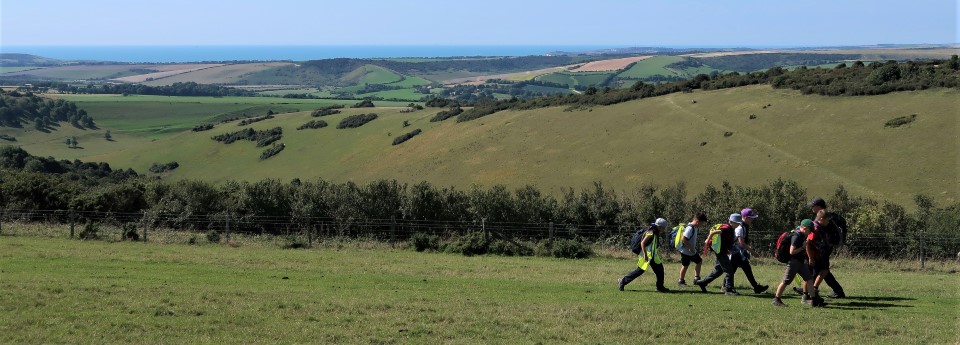If you don’t have some of the things on this list then don’t panic. We do have some spares at the hut. Just let us know in advance.
Some shops such as Go Outdoors, Blacks and Millets offer a Scouting discount, see here for details.
If you are buying boots then make sure that they are very comfortable and don’t pinch or rub anywhere. Wear them all week if you can to get them worn in. If there is some movement in your boots then try putting a padded insole into the boots first or adjust the lacing.

Kit
- Backpack or daysac – 25 litres capacity with a proper waist belt would be ideal.
- Small torch – An LED head torch is recommended. A red torch does not ruin your night vision and does not dazzle people so much.
- Whistle – only to be used in emergencies!
- A cup – unbreakable and insulated if possible.
- A compass – if you have one. Not compulsory but recommended.
Clothing
Preferably not in bright colours!
- No jeans! – Scout uniform trousers, combat or hiking trousers are perfect. Purpose-made hiking trousers are usually water-resistant too.
- Scout scarf and woggle (to be worn) – Ensure that woggle cannot slip off (tie a simple knot in the end).
- Hiking boots – Ensure they fit properly prior to the hike.
- Waterproof (NOT water-resistant) over- trousers – For downpours.
- Waterproof (NOT water-resistant) jacket – preferably with taped seams, a hood and cuffs that tighten. This item is probably more expensive than your boots but will be your life-saver in all weathers. A must-have for mountain expeditions.
- 2 hats – a woolly hat for when it turns cold and a peaked cap to keep the sun off your head when it’s sunny.
- Warm gloves or mittens – waterproof if possible. Mittens tend to be warmer and easier to get on and off. Snowboarding mittens are excellent!
- Warm fleece or even better a down (quilted) top.
For every hike you should use multi layers.
First a sports t-shirt that wicks moisture away from your skin.
Next a long-sleeved thin fleece. Purpose made ‘mid layers’ usually have a hood.
On top of that you should have an ‘outer layer’ – a thick fleece or a down (quilted) top for when it gets cold. Down-filled items are excellent as they weigh nothing and are warm. They also pack up incredibly small. Synthetic equivalents to down are also available and can cope better in damp conditions.
Finally a waterproof jacket over the top with its own integral hood. If it starts raining or if it gets really cold then you can put your waterproof trousers on and wear your thermal hat.
Walking keeps you very warm and usually the trouble is over-heating and not freezing but you will get colder when you stop walking and also of course after dark.
Outer clothing and boots can be further waterproofed by using Nikwax or similar products that are available in all outdoors shops.
Make sure your toenails are cut correctly in the right way (don’t cut them if they don’t need it) and that your hiking boots are clean and your laces are in good condition.
Lunch
- 1L Water bottle (full) – make sure it doesn’t leak.
- 2 rounds of Sandwiches – (in a tupperware box to stop them getting mashed up). Cheese and tomato is excellent walking fuel.
- Some fruit, some cake and/or dried fruit – A good old-fashioned fruit cake is filling and supplies lots of energy over a long period.
- An ‘emergency’ chocolate bar.
- Tea or soup in a small flask (Compulsory). Make sure before the hike that it doesn’t leak.
- Small sweets to share with everyone – Polo’s, boiled sweets, wine gums. If everyone shares with everyone we all get a nice selection during the walk. Try to avoid individually wrapped sweets as the wrappers get everywhere.
- NO NUTS PLEASE – we have members with nut allergies.
Walking uses up a lot of calories so make sure you bring enough good, filling food for the whole day. Try to keep packaging to a minimum to save space and waste.
Please take all packaging, fruit peels, skins and cores home with you and dispose of them properly.
Packing
- All of your kit should fit inside your backpack along with your jacket and waterproofs when you’re not wearing them. So make sure your bag is big enough.
- No items (except the whistle) should be hung on the outside of your backpack.
- Pack everything tidily in your backpack making use of any free space available and make sure nothing rattles. Clothes can be rolled up and pushed into any available space. Try to have the heaviest things near the top of the pack and the things you don’t need very often at the bottom.
- Scouts should pack their own bags so that they know they have everything on this list and also so that they know where everything is in their pack.
- You are free to carry anything else that you wish to bring, just make sure that you have room and that you can carry it all.
- Whenever possible pack ‘ultra lightweight’.
- Remember – there is no such thing as bad weather: just inappropriate clothing!







